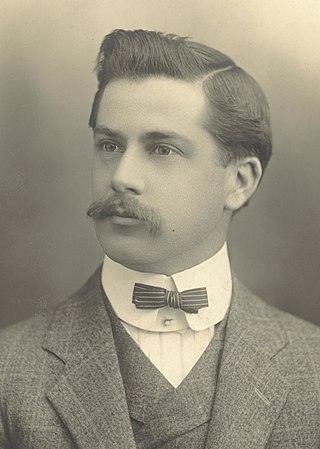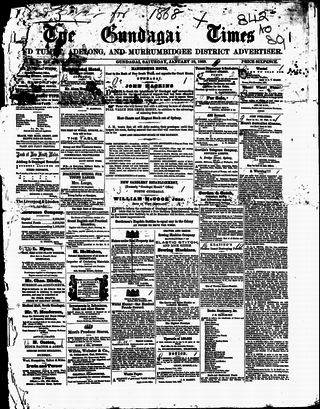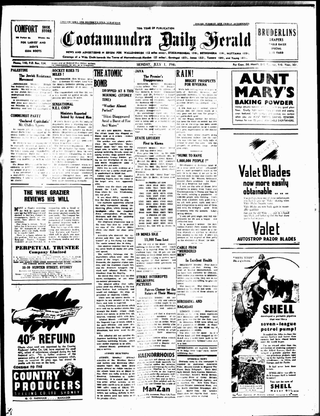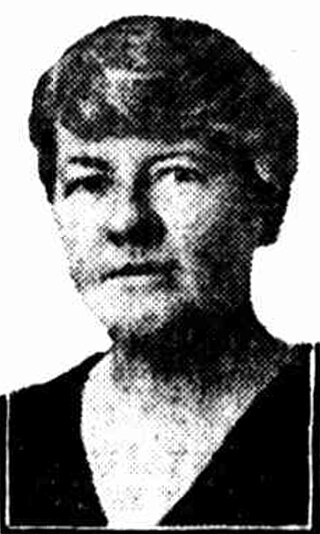
Group 9 is a rugby league competition based in Wagga Wagga, New South Wales, Australia, and surrounding areas. The competition is played in five grades, with these being Under 16s, Under 18s, Women's League-Tag, Reserve-Grade and First-Grade.

Cootamundra, nicknamed Coota, is a town in the South West Slopes region of New South Wales, Australia and within the Riverina. It is within the Cootamundra-Gundagai Regional Council. At the 2016 Census, Cootamundra had a population of 6,782. It is located on the Olympic Highway at the point where it crosses the Muttama Creek, between Junee and Cowra. Its railway station is on the Main Southern line, part of the Melbourne-to-Sydney line.

Australian rules football in New South Wales is a team sport played and observed in the Australian state. It dates back to the colonial era in 1866, with organised competitions being continuous since the 1880s. Today, it is popular in several regions of the state, including areas near the Victorian and South Australian borders—Riverina, Broken Hill, and South Coast. These areas form part of an Australian cultural divide described as the Barassi Line. To the east of the line, it is known as "AFL", named after the elite Australian Football League competition. AFL NSW/ACT is the main development body, and includes the Australian Capital Territory.
The Clayton Cup is a trophy that was awarded by the Country Rugby League to the NSW country rugby league team with the best overall record for that season. To be eligible, the team must win the highest level of competition in its region. Usually the winner of the Clayton Cup goes through the season undefeated. In late 2019, the Country Rugby League was absorbed by the New South Wales Rugby League.
Dirnaseer is a locality in the north east part of the Riverina and situated about 42 kilometres south east of Temora and 50 kilometres west of Cootamundra. At the 2006 census, Dirnaseer had a population of 170 people.

John (Johnny) Graves was an Australian rugby league footballer who played in the 1940s and 1950s. An Australian international representative goal-kicking wing, he played his club football for the South Sydney Rabbitohs, with whom he won back-to-back premierships in 1950–51.

James Howard Catts was an Australian politician, unionist and businessman.
Jack Moses was an Australian outback bush poet who wrote the poem "The dog sat on the tuckerbox" from which the well-known Dog on the Tuckerbox monument and the Nine and Five Mile legend of Gundagai were inspired.
Alfred Edgar Hunt, generally referred to as A. E. Hunt, was an Australian politician and a member of the New South Wales Legislative Council for 13 years.

The Farmer & Settler was an English-language broadsheet newspaper published in Sydney, Australia, between 1906 and 1957. It was primarily published weekly.

The Gundagai Times and Tumut, Adelong, and Murrumbidgee District Advertiser, often referred to as simply the Gundagai Times, was a newspaper published in Gundagai, New South Wales, Australia from 1868 to 1931. It was a direct successor of The Wynyard Times and Tumut and Adelong Advertiser and The Tumut and Adelong Times, published in Tumut, New South Wales, and was absorbed into The Gundagai Independent in 1931.

The Cootamundra Herald is a former printed bi-weekly newspaper now existing only on-line and containing little or no news of direct relevance to the community of Cootamundra, New South Wales, Australia. The Herald website carries syndicated non-local copy with occasional government media releases referring to local issues. Following the purchase of the masthead in 2019 by Australian Community Media, the Herald office which had existed for 144 years in the main street was closed and local staff were forced to work part-time from home. The staff resigned or were eventually sacked, and there are now no local Herald employees generating content related to the town.
The Cootamundra Jazz Band, based in the New South Wales town of Cootamundra, was one of Australia's foremost traditional jazz bands of the 1950s, and the fore-runner of the Riverina Jazz Band based in nearby Wagga Wagga.
Bob Holder is a champion rodeo rider of Cootamundra, New South Wales, in 2019 reckoned as the world's oldest professional in the sport.
Thomas Smith Bellair was an English actor who moved to Australia, where he had his own dramatic company before managing various hotels, finally settling in Wagga Wagga, where his family became prominent citizens.
Brighton College was a non-denominational day and boarding private girls' school in Manly, New South Wales, Australia. It operated from 1889 to 1960 in the suburb of Manly, Australia.

Florence Campbell was an Australian educator. She served as headmistress of Sydney Girls High School from 1919 to 1941.
The Pastoralists' Union of New South Wales was an association of landholders in Australia, founded in 1890. In 1916 it was renamed Graziers' Association of New South Wales, one of the founders of the Progressive Party of New South Wales, which became New South Wales National Party.
Ethelbert Ambrook Southee, invariably referred to as E. A. Southee or Bert Southee, was an Australian educator.









